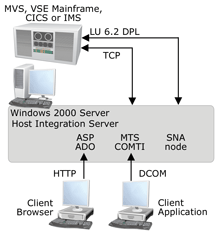Solution
One solution for integrating host application systems with Windows-based applications, including the Web, is by using Microsoft Transaction Integrator, Microsoft Component Object Model (COM) technology, and Microsoft Visual Studio .NET Application Integration Tools. This combination of technologies enables you to quickly build Web front-ends to host applications and data with little or no changes to the host code. The COM Transaction Integration (COMTI) technology is part of the Microsoft® Host Integration Server 2000 and integrates IBM mainframe-based transaction programs managed by the Customer Information Control Systems (CICS) and Information Management Systems (IMS).
The transaction integration technology enables data to be obtained from mainframe-based transaction programs (TPs), transferred, and used in component-based Windows® 2000 COM or distributed COM (DCOM) applications, when a synchronous or transactional solution is needed.
True integration of online transaction processing (OLTP) with COM-compliant systems means the integration of CICS and IMS with Windows-based solutions. CICS and IMS are widely used in the mainframe arena to create distributed OLTP solutions, such as customer tracking and order entry solutions. COMTI integrates CICS and IMS with COM by creating COM interfaces to the CICS and IMS transactions and running the CICS and IMS transactions on the mainframe from Windows.
COMTI preserves existing CICS and IMS TPs in either a three-tier client/server or Web-to-host computing environment. By using COMTI to invoke mainframe transactions, you can write programs in object-oriented environments and programming languages such as Visual Basic or C#, while still having access to host transactions.
Both SNA and TCP/IP connectivity is supported by COMTI. SNA connectivity is used if you need two-phase commit (2PC) type processing. TCP/IP connectivity is used if you need direct throughput. IBM has not implemented 2PC in the TCP/IP protocol, but for those cases where 2PC is not needed, TCP/IP can give you direct connectivity.
The following figure shows a conceptual overview of the COMTI architecture.

COMTI architecture
COMTI has two graphical user interfaces, COMTI Component Builder and COMTI Manager, and also contains the COMTI run-time environment that automatically handles the actual transaction integration. COMTI Component Builder is used to turn COBOL TPs into COMTI components (type libraries) that include COMTI run-time environment settings. COMTI Manager is used to configure and manage the following application integration services:
- COMTI components and their embedded COMTI run-time environment settings
- Remote environments in the SNA or TCP/IP network
- COM+ applications (or MTS packages)
A COMTI component in a COM+ application or older Microsoft Transaction Server (MTS) package works in concert with the COMTI run-time environment, Microsoft Distributed Transaction Coordinator (MS DTC), and the associated remote environment (RE) to drive a CICS or IMS Transaction Program (TP). Together, they accomplish these tasks:
- Activate the host (mainframe) TP
- Pass the parameters specified by the COMTI component to the TP
- Run the TP
- Return the results to the COMTI component
Once a COMTI component (a type library, .tlb file) is deployed in a COM+ application, that COM+ application becomes known as an automation server. When a client application calls for the services of (invokes) a method in that COMTI automation server, Windows automatically starts the COMTI run-time environment in the associated remote environment to invoke the mainframe transaction that is associated with that COMTI method. Component Services in Windows 2000 (or MTS in Windows NT 4.0) automatically handles any class factory, early or late binding, or other internal operations needed. The invoked mainframe transaction can call other transactions on the mainframe before returning the result to the COM-based client application through the COMTI Automation server.
Complete information on COMTI is available in the Host Integration Server 2000 documentation.
| Previous Next |
EAN: 2147483647
Pages: 483
- Chapter I e-Search: A Conceptual Framework of Online Consumer Behavior
- Chapter VI Web Site Quality and Usability in E-Commerce
- Chapter IX Extrinsic Plus Intrinsic Human Factors Influencing the Web Usage
- Chapter XI User Satisfaction with Web Portals: An Empirical Study
- Chapter XVIII Web Systems Design, Litigation, and Online Consumer Behavior